ASDA: A History of Action
Dental Students Decide to Organize
The Initial Step
ASDA is Born
ASDA's Early Years
ASDA Today: A Channel for Dental Student Concerns
Capturing Support of Legislators
Dental Licensure Reform
Access to Care/Barriers to Care
ASDA: The Future
Dental Students Decide to Organize
 The year was 1969. University students across the country staged demonstrations to protest the Vietnam War, restrictive school policies, dress codes and more. Dental school admission criteria became more selective and the competition for acceptance into dental schools increased. The resulting student profile was a brighter, more socially aware individual with diverse interests and talents.
The year was 1969. University students across the country staged demonstrations to protest the Vietnam War, restrictive school policies, dress codes and more. Dental school admission criteria became more selective and the competition for acceptance into dental schools increased. The resulting student profile was a brighter, more socially aware individual with diverse interests and talents.
However, at this time dental school could be likened to boot camp. In fact, many instructors were indeed retired military officers. Students were told how long to wear their hair and sideburns. Some schools even had fingernail inspections. Only a handful of women and minority students could be found in dental school. To make matters worse, no system of due process existed, which meant students could be expelled with no available recourse for help. With a multitude of issues building, the solution presented itself-dental students needed to organize.
The Initial Step
That year the federal government offered the Student American Medical Association (SAMA) a $1 million grant to coordinate student involvement in the Appalachia Project and the American Indian Health Program. Dentistry was the only health care discipline without its own national student organization. In order to receive the grant for the project, SAMA needed dental students to organize.
The presidents of SAMA (now known as the American Medical Student Association) and the Student American Pharmacy Association both attended the University of California at San Francisco. They approached Dennis Spain, a junior at the university's dental school, to start a national association for dental students.
At a January 1970 SAMA conference that included professional students of all disciplines, Spain met David Evaskus, a senior dental student at the University of Illinois. Impressed with the scope and depth of the projects in which the other student organizations were involved, Spain and Evaskus returned to their schools and began contacting dental school deans and students across the country.
Students held a meeting in Chicago on Feb. 14-15, 1970, just prior to the midwinter meeting of the Chicago Dental Society. Although records indicate that 45 students from 26 dental schools participated, more dental schools may have been unofficially represented because several students came to the meeting without the approval of their schools' administrations. This assembly represented a new generation of dental students. Active students involved in extracurricular activities were in attendance, rather than the usual assemblage of student body presidents or faculty-recognized students.
This new brand of leaders formed the Student American Dental Association (SADA), a national organization that would recruit students to serve in federal health care projects, function as an information clearinghouse on local student issues, coordinate student lobbying efforts and establish and promote student positions on professional issues. Members elected Dennis Spain, the original organizer, as board president. The newly established SADA planned to hold its first national convention and House of Delegates meeting in New York in October 1970.
ASDA is Born
SADA wanted to maintain its independence but was unable to attract enough funding to support its planned national convention. At the same time, the American Dental Association began developing its
own plans for student affairs to channel student requests to the
appropriate ADA departments. Approved at the 1970 ADA Annual Session,
one of the first activities was to help organize a dental student
convention, which was later held on Feb. 8-9, 1971.
The culmination of the conference was the formation of the American Student Dental Association (ASDA), a new national student dental organization. Its first president and other key officers were former SADA leaders. While this new organization had the ADA's approval and support, ASDA's guiding principles and leaders descended directly from the original student organization, SADA. See all of ASDA's past presidents.
The Early Years
 In its first year, ASDA participated in minority student recruitment, migratory worker health programs in several states and Indian Health Service programs. In addition, the association published a monthly newsletter and held regional conferences on issues concerning public health.
In its first year, ASDA participated in minority student recruitment, migratory worker health programs in several states and Indian Health Service programs. In addition, the association published a monthly newsletter and held regional conferences on issues concerning public health.
One of ASDA's earliest activities was the development of an advocacy program to respond to students' requests for support and assistance. ASDA's Advocacy Program helped students by either directing them to local sources of assistance, forwarding cases to the ADA Commission on Dental Accreditation, or simply shedding light on injustices through ASDA's newsletter.
Also in 1986, ASDA established its Political Education Network, comprised of students who coordinate legislative activities and lobbying efforts at their dental schools. PEN monitored state and national legislative activities and organized political action at the grassroots level, such as letter-writing campaigns and voter registration drives. ASDA initiated its political advocacy network of dental students nearly 10 years before the ADA created its grassroots network for dentists. In the fall of 2000, ASDA changed PEN's name to the Legislative Grassroots Networks to better reflect its purpose and efforts. In 2013, after the continued evolution of the LGN, ASDA changed the name to the Council on Advocacy.
ASDA Today: A Channel for Dental Student Concerns
 ASDA is the largest national organization solely dedicated to dental student concerns. Structured as a network of chapters based at each of the 66 U.S. dental schools, ASDA is uniquely geared to respond to its members at the local, regional and national levels.
ASDA is the largest national organization solely dedicated to dental student concerns. Structured as a network of chapters based at each of the 66 U.S. dental schools, ASDA is uniquely geared to respond to its members at the local, regional and national levels.
Two delegates at each dental school chapter serve as voting members of the ASDA House of Delegates. Their role is to voice the concerns of their constituents to the House of Delegates for action in the form of resolutions. As a result of passed resolutions, ASDA publishes policy statements on several issues, including dental education, licensure, dental research, midlevel providers and education financing. ASDA notifies groups or individuals, such as dental school deans, dental associations, state boards of dentistry and lawmakers, of its position on particular issues.
Capturing Support of Legislators
In 1999, ASDA joined with the American Dental Education Association to host the first National Dental Student Lobby Day. For more than 10 years now, students have gathered in Washington, D.C. to actively lobby members of Congress. This unique experience provides ASDA members an opportunity to meet with their legislators and advocate for their profession.
Recent issues that ASDA has lobbied for:
- Earnings Contingent Education Loans (ExCEL) Act
- Protect Medical Innovation Act
- Funding for the National Institute of Dental and Craniofacial Research and the National Institutes of Health
- Dental Emergency Responder Act of 2011
- Student Loan Interest Deduction
- Regulation of Tobacco by the Food and Drug Administration
- Meth Mouth Prevention and Community Recovery Act
Dental Licensure Reform
ASDA supports the universal acceptance of all regional and state clinical licensing examinations. ASDA is leading the charge for the elimination of live patient exams to protect the public and ethical integrity of the profession. Our efforts to reach out to state dental associations to encourage them to adopt similar policies have been successful. Click here for more on the current state of licensure.
In 2010, bill AB 1524 was passed in California that recognizes licensure by portfolio. This innovative approach to licensure opens up opportunities in other states. ADA has created a workgroup to develop a portfolio-style examination for the purpose of initial dental licensure. An ASDA representative is a member of the task force assigned to this project.
Access to Care/Barriers to Care
Barriers to care is a major professional issue in dentistry. There have been many options proposed to solve this problem. One potential solution is the addition of a mid-level provider in the dental profession. ASDA endorses expanded functions for dental auxiliaries only when each has received the appropriate education and training to guarantee competence, and when such functions fall within the laws established by their respective state of employment. Because of the comprehensive education and training requirements for dentists, ASDA believes that only dentists should perform irreversible procedures and prescribe medications.
ASDA: The Future
ASDA has grown into a strong, well-respected and influential organization. Today, nearly 90 percent of all dental students join the association. ASDA also offers membership to predental students and continues to work to assist students interested in entering dental school by providing them with valuable information and resources.